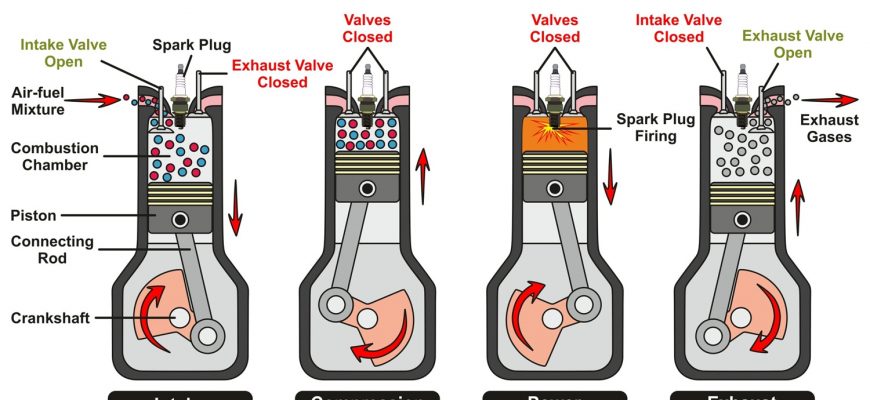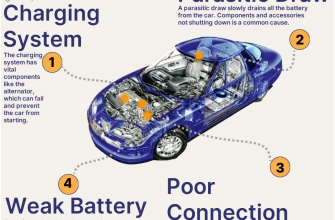When it comes to the intricate world of automobile engineering, few components are as crucial as the cylinder․ Often overshadowed by the glitzy exterior of a car, the cylinder is the heart of the engine, where the magic of combustion takes place․ In this article, we will delve deep into the role of a cylinder in an automobile engine, exploring its function, design, and significance in the overall performance of a vehicle․
- The Basics of Engine Design
- What is a Cylinder?
- The Combustion Process
- Types of Cylinders
- Importance of Cylinder Design
- The Evolution of Cylinder Technology
- Direct Fuel Injection
- Variable Valve Timing
- Turbocharging and Supercharging
- Challenges and Considerations
- The Cylinder’s Role in Performance and Efficiency
- Enhancing Engine Longevity
- The Future of Cylinder Engineering
- Hybrid and Electric Innovations
- The Cylinder’s Contribution to Performance Tuning
- The Cylinder in Motorsports
The Basics of Engine Design
To grasp the importance of cylinders, it’s essential to understand the basic structure of an internal combustion engine․ Typically, an automobile engine is made up of multiple cylinders arranged in a configuration—commonly inline, V-shaped, or flat (boxer)․ Each cylinder plays a pivotal role in the engine’s operation, contributing to the power output and efficiency of the vehicle․
What is a Cylinder?
A cylinder is a cylindrical chamber within the engine where the fuel-air mixture is ignited, leading to combustion․ This combustion pushes a piston connected to a crankshaft, ultimately translating into rotational power that drives the vehicle․ The key components involved in this process include:
- Piston: A movable component that compresses the fuel-air mixture and transmits the force generated by combustion․
- Combustion Chamber: The space above the piston where the fuel-air mixture is ignited․
- Valve System: Includes intake and exhaust valves that control the flow of air and exhaust gases in and out of the cylinder․
The Combustion Process
The journey of fuel begins when it enters the cylinder through the intake valve․ As the piston moves down, it creates a vacuum that draws in the air-fuel mixture․ Once the piston reaches the bottom of its stroke, the intake valve closes, and the piston moves up, compressing the mixture․ This compression is vital for an efficient combustion process․
At the peak of the piston’s travel, a spark plug ignites the compressed mixture, causing an explosion that forces the piston downwards․ This motion is what ultimately powers the vehicle․ The exhaust valve then opens to release the combustion gases, and the cycle repeats as the piston moves back up․
Types of Cylinders
Cylinders can come in various designs and configurations, each affecting engine performance differently:
- Inline Cylinders: Arranged in a straight line, commonly found in smaller and mid-sized engines․
- V-Shaped Cylinders: Arranged in two banks forming a V, typically found in larger vehicles and performance cars for increased power․
- Boxer Cylinders: Horizontally opposed cylinders that reduce the engine’s height and lower the center of gravity․
Importance of Cylinder Design
The design and material of a cylinder significantly influence an engine’s efficiency, power output, and durability․ Key factors include:
- Material: Cast iron and aluminum alloys are commonly used for their strength and heat resistance․
- Cylinder Bore: The diameter of the cylinder, which affects the engine’s displacement and power․
- Stroke Length: The distance the piston travels in the cylinder, influencing torque and horsepower․
The Evolution of Cylinder Technology
As we venture into the future of automotive engineering, the evolution of cylinder technology plays a pivotal role in enhancing efficiency and performance․ Innovations such as direct fuel injection, variable valve timing, and turbocharging have transformed traditional designs, allowing for greater power output while maintaining fuel economy․ These advancements are not merely incremental; they represent a paradigm shift in how power is generated within an engine․
Direct Fuel Injection
Incorporating direct fuel injection systems allows fuel to be injected directly into the combustion chamber at high pressure․ This method enhances the atomization of the fuel, leading to more efficient combustion and improved power delivery․ It also reduces emissions and enhances fuel efficiency, addressing the growing demand for environmentally friendly automotive solutions․
Variable Valve Timing
Variable valve timing (VVT) technologies, such as VTEC and VVT-i, allow for the optimization of valve timing based on engine speed and load․ By adjusting the timing of the intake and exhaust valves, engines can achieve better performance across a broader range of operating conditions․ This leads to improved acceleration, reduced fuel consumption, and lower emissions, showcasing how cylinder design can adapt to modern needs․
Turbocharging and Supercharging
Turbochargers and superchargers are vital in squeezing more power from smaller engines․ By forcing more air into the cylinder, these devices enable the engine to burn more fuel, thus producing greater power without significantly increasing the engine size․ This trend towards smaller, turbocharged engines reflects a growing focus on performance without sacrificing efficiency․
Challenges and Considerations
Despite the advancements in cylinder technology, engineers face several challenges․ Heat management remains a critical concern, as higher combustion temperatures can lead to engine knock and premature wear․ Manufacturers must balance performance enhancements with durability, ensuring that cylinders can withstand the rigors of modern driving conditions․
Moreover, as regulatory pressures for reduced emissions intensify, the automotive industry must innovate continually․ Future cylinder designs will likely incorporate alternative fuels, hybrid technologies, and even electric powertrains, ushering in a new era of automotive propulsion․ The cylinder, while a traditional element, will evolve to meet these changing demands․
The Cylinder’s Role in Performance and Efficiency
The interplay between the cylinder and engine performance is undeniable․ A well-designed cylinder can significantly enhance an engine’s efficiency, translating to better fuel economy and reduced emissions․ This is particularly important in today’s market, where consumers are increasingly eco-conscious and manufacturers are striving to meet stringent environmental regulations․
Enhancing Engine Longevity
Another critical aspect of cylinder design is its impact on engine longevity․ High-quality materials and advanced engineering techniques can minimize wear and tear, extending the life of the engine․ As automotive technology continues to advance, manufacturers are investing in research to develop cylinders that can withstand harsher conditions while also improving overall engine reliability․
As we look ahead, the cylinder’s role in automotive engineering is set to transform dramatically․ With ongoing advancements in technology and a growing emphasis on sustainability, cylinders will undoubtedly adapt to meet the demands of tomorrow’s vehicles․ Understanding the intricacies of cylinder design and function not only enriches our knowledge of automotive mechanics but also highlights the importance of innovation in an ever-evolving industry․
In essence, the cylinder is more than just a component; it is a testament to the ingenuity and progress of automotive engineering․ As we embrace new technologies and methodologies, the cylinder will remain a critical player in the quest for more efficient, powerful, and environmentally friendly vehicles․
The Future of Cylinder Engineering
As the automotive industry pivots towards sustainability, the future of cylinder engineering will likely be shaped by a blend of innovative materials and cutting-edge technologies․ Lightweight composites, for instance, may replace traditional metals, reducing the overall weight of the engine and enhancing fuel efficiency․ Moreover, the integration of smart technology into cylinder design could lead to real-time monitoring of pressure and temperature, allowing for adaptive performance adjustments that optimize efficiency and reduce wear․
Hybrid and Electric Innovations
The rise of hybrid and electric vehicles is also influencing cylinder technology․ While traditional internal combustion engines are not entirely obsolete, manufacturers are increasingly exploring how to integrate cylinder designs with electric powertrains․ This hybridization allows for a more versatile approach to vehicle performance, offering the power of combustion when needed while relying on electric motors for everyday driving efficiency․
Additionally, advancements in battery technology could lead to the development of hybrid systems where cylinders are used for unique applications, such as range extenders․ This could provide a bridge in the transition from conventional engines to fully electric solutions, catering to consumers who seek performance without compromising on environmental responsibility․
The Cylinder’s Contribution to Performance Tuning
For car enthusiasts and performance tuners, the cylinder remains a focal point for upgrades and modifications․ From increasing bore size to enhancing airflow through advanced valve designs, the potential for performance tuning is vast․ Aftermarket parts specifically designed for cylinders can significantly boost horsepower and torque, allowing enthusiasts to customize their vehicles to fit their driving styles․
Moreover, understanding the interplay between the cylinder and other engine components—such as the intake and exhaust systems—can unlock additional performance gains․ The tuning community often emphasizes the importance of a balanced approach, where modifications to the cylinder are complemented by adjustments elsewhere in the engine to create a harmonious and powerful driving experience․
The Cylinder in Motorsports
In the world of motorsports, the cylinder’s role is accentuated․ Engineers and mechanics constantly strive to maximize every aspect of engine performance, and the cylinder is at the heart of these efforts․ The design and tuning of racing cylinders are honed for extreme conditions, where every fraction of a second counts․ Advanced technologies, such as variable geometry systems and high-performance coatings, are employed to push the limits of what’s possible․
The cylinder’s ability to handle higher pressures and temperatures while delivering optimal power is crucial in racing environments․ Racetracks serve as testing grounds for innovations that will eventually trickle down to consumer vehicles, further bridging the gap between performance and everyday driving․
Ultimately, the cylinder embodies the ongoing evolution of automotive engineering․ It is not merely a component but a representation of the intricate balance between power, efficiency, and sustainability․ As technological advancements continue to reshape our understanding of performance, the cylinder will adapt, reflecting the ever-changing landscape of the automotive industry․
From traditional combustion engines to the hybrid and electric future, the cylinder will remain a vital player in the quest for innovation․ As we embrace the challenges and opportunities ahead, understanding the nuances of this essential engine component will pave the way for a new era of automotive excellence․ Embracing change while honoring the legacy of the cylinder will ensure that the heart of the engine continues to beat strong for generations to come․










Fantastic article! The way you explained the role of pistons and valves in conjunction with cylinders made everything so clear.
This article is a must-read for anyone interested in automobiles. The insights on cylinders are incredibly valuable!
I appreciated the detailed breakdown of engine design and cylinder function. It really highlights the engineering behind our cars.
I never realized how crucial the cylinder is to an engine
I loved how this piece highlighted the often-overlooked components of an engine. Cylinders are truly fascinating!
The explanation of the combustion process was clear and engaging. Great job on making complex concepts easy to understand!
This article does a fantastic job of breaking down the importance of cylinders in vehicle performance. I learned so much about how they work!
This article has sparked my interest in automobile engineering. I want to learn more about how engines work now!